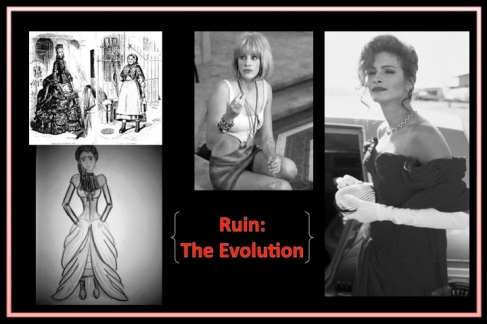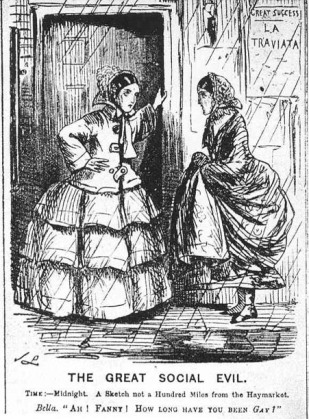Alexis Burt
11/9/12
Humanities 303
Gender and Media Study
“Goblin” & “Mermaid: Comparison of Victorian and Contemporary Views of Sexuality and Gender
Christina Rossetti’s “The Goblin Market” is a piece of Victorian poetry about two close sisters tempted and spoiled by the fruits of a band of goblin vendors. The poem, originally written for children, has strong sexual symbolism. The symbolism allows for the poem adult themes to subtly subsist in the piece. The two sisters, Laura and Lizzie, begin the poem innocent and naïve. Laura is then corrupted by the lure of the goblin’s fruit, listed off as an entire stanza in the poem. She is intrigued by the goblin men, the likes of which she had never seen before. Her curiosity and the charms of the band of men tempt her to taste of the fruit. This does not come without a price however. Without any copper or silver in her purse, Laura pays for the fruit with a lock of hair from her golden head and a tear “more rare than a pearl”. She then partakes of the fruit. Rossetti describes it using sexually charged diction, describing that Laura:
“Then suck’d their fruit globes fair or red:
Sweeter than honey from the rock,
Stronger than man-rejoicing wine,
Clearer than water flow’d that juice;
She never tasted such before,
How should it cloy with length of use?
She suck’d and suck’d and suck’d the more
Fruits which that unknown orchard bore;
She suck’d until her lips were sore.”
This passage is such a strong innuendo that makes the poem hard to conceive as children’s literature. The introduction to the goblins’ role in the sisters’ lives is also fraught with phallic symbols. Lizzie warns Laura about the goblins, cautioning that they don’t know what the goblins’ “hungry thirsty roots” feed on. Both sisters recognize the danger that the men present but Laura is unable to resist.
After succumbing to the temptation of the goblins’ fruit, Lizzie meets Laura at the gate, symbolically separating the two sisters as innocent and sinful. The poem continues to put the sisters in opposition of each other, Lizzie delights in the day while Laura longs for the temptations of the night. The sisters are equally prosperous in their daily lives until Laura realizes that Lizzie can hear the calls of the goblin men and she no longer can. She longs another taste of the goblin fruit and is denied. This passage defines the corruptive power of sex as dangerous only when it becomes a craving that cannot be satisfied. After Laura realizes Lizzie can hear the calls and she no longer can, her hair turns grey and she can no longer carry on her everyday duties, beginning to wither away. Laura’s submission to sex becomes a poison in her life, figuratively killing her.
To save her sister, Lizzie sacrifices her innocence and seeks out the goblin men. Only instead of paying with her body, Lizzie offers the men a silver coin. In response, the men become violent and malicious. The goblins “tore her gown and soil’d her stocking,/ Twitch’d her hair out by the roots/…Held her hands and squeez’d their fruits/ Against her mouth to make her eat.” She continues with the brutality, including more sexual references, “laugh’d in heart to feel the drip/ Of juice that syrupp’d all her face,/ And lodg’d in dimples of her chin,/ And streak’d her neck which quaked like curd.” Lizzie’s valiant attempt to get fruit for her sister resulted in her own sexual exploitation. The goblins’ attack, however, did not taint Lizzie as it did Laura. Because she took a stance against the men, their juices tasted of wormwood and disillusioned Laura from the power that the goblin fruit held over her.
Even without interpreting the text as a sexual piece, the message the text delivers is still one of unified sisterhood. Lizzie rescues Laura from the spell the goblin men held over her and they both go on as unsoiled women to be wives and mothers. The last stanza regales the power that elevating the bonds between women over the poisons men bring: “For there is no friend like a sister/ …To fetch one if one goes astray,/ To lift one if one totters down,/ To strengthen whilst one stands.” The piece makes a strong statement about the role that women should play in each other’s lives. It renounces men as carnal, malicious, impulse-driven creatures who will treat women as disposable sexual objects if women allow them to.
Disney’s The Little Mermaid, like Rossetti’s “Goblin Market”, is presented as a work of fiction for children, though it is riddled thematically with anti-feminist and adult themes. Though less morally driven than Rossetti’s piece, The Little Mermaid holds many of the same themes. The film is a coming-of-age story of a mermaid who falls in love with a human prince and goes on a quest for true love’s kiss with the prince. To do this, she makes a deal with the sea witch to give up her voice, touted as the most beautiful in the entire kingdom, for legs. She then has three days to win his affections and remain human or return to the sea and belong to the sea witch. The main character, Ariel, is sixteen years old, the film is fantastical and nautical, and the music keeps the violent and dramatic scenes from becoming overly dark, all this an appeal to an audience of children. Beneath the plot, however, the film is piece of sterilized sexuality, an implied intermediary for the mature inclination toward sexuality.
Ariel’s story follows her journey from daughter to wife, implicitly, her exploration of her sexuality. Under the sea, Ariel has a secret collection of human objects that have fallen from the surface. She idolizes these items and keeps them in a private cavern. The opposition of her life under the sea to her fantastic fascination with the human world foreshadows the transition of Ariel from girl to woman as the sea world represents her childhood and the human world representing adult sexuality. She then leaves the safety of her father’s kingdom to go to the human world. Ariel chooses to leave her father’s protection and her juvenile voice, both with again symbolize her childhood, behind, choosing instead to entire a world as a young single woman in the unbridled human world.
Her life as a human is a transition of physicality more than an emotional transition, like a traditional children’s coming-of-age story. Firstly, she emerges on the surface physically naked, much like Aphrodite emerging from the sea as the goddess of love, again an allusion to the sexual nature of this film. She then has to learn to walk, dance, ride horses, and use her body as a form of communication between her and the prince, all new physical experiences for her, representative of the physicality in sexual exploration. Eric takes Ariel on a tour of his kingdom, furthering her exploration of a world that was unknown to her. As far as the central sexual narrative is concerned, the importance of Prince Eric, a man, introducing Ariel, a woman, to his kingdom can be interpreted as an introduction into the mature adult world.
The film also makes human strong references to human reproductive organs. Interpreting the film through a Freudian lens, Ariel’s red hair, the most striking and overwhelming feature of her appearance, represents menarche, a girl’s first step into womanhood. Viewing this as her most significant characteristic, Ariel is marked by her inexperience in adulthood. The phallic and womb-like symbols in the film also parallel Ariel’s passage from girl to woman. The film opens with a view of her father, Triton’s, castle. The phallic towers in this castle imply the power and control her father still has over her. Then, Ariel takes solace and refuge in her cavern, one of the few womb-like structures in the film. This shows her choosing her own needs over her father’s wishes, foreshadowing the exploration she is about to embark into. Ariel returns to her father’s castle only to be tempted by eels, another phallic symbol. The eels lead her to Ursula’s cave, a figurative structure for the female form. Betrayed by the sea witch, Ariel turns to a different set of towers, Eric’s castle. Her decision to live within Eric’s castle is emblematic of Ariel’s immovable stance as an adult woman. These references are lost on a contemporary audience because the film is marketed as a children’s film.
Though the thematic content of these two pieces are similar, the Victorian era poem is a much more empowering piece for women than the contemporary film. Rossetti’s piece glorifies the role of women in each other’s lives. Women have sacrificial restorative powers. Sexuality and a dependence on men ruined Laura, almost killing her. Though they can be misused as sexual objects, their lives revolve around more than the needs of men. Interestingly, the contemporary interpretation of gender and sexuality denounces that belief.
Similar to the way the sexual themes are looked over in The Little Mermaid, the reinforcement of traditional male-oriented are also overlooked. Little girls see Ariel as a hero: she takes initiative in her own life, stands up to her father to follow her heart, and ends up as a princess. Ariel is seen as a model for individualism and emphasizes a younger generation’s needs, desires, and importance. From an adult perspective looking specifically at the statement the film makes about gender roles, the film is degrading, a denigration of the role women play in their own lives. Ariel gives up her voice and family to submit herself to a man. The film doesn’t show her as a powerful political figure at the end as a princess would be; she’s ultimately just a wife. Ariel willingly gave up her voice and after she is accepted into Eric’s life as the person he wants to marry, she has very little dialogue in the rest of the film. The movie ends in a kiss, teaching young girls that the love of a man is the only thing in the world they should hope to achieve. Women, mainly Ariel and Ursula, are portrayed as impulsive, emotion-driven, untrustworthy, and destructive while men are protectors, providers, guardians, and the greatest thing that a woman can ever hope to solidify in her life. The Disney message is that women are driven by a desire for men.
The contemporary view of women is much more marginalized. Women are either rebellious and wildly independent, like Ariel still as a mermaid, or dependent on the needs of the man in their life, like Ariel on land. Women are quickly objectified: Ariel transitioned from outspoken young girl to silent wife. There is no return from that objectification mostly because Ariel wants nothing more than to be Eric’s. Lizzie and Laura have each other, which makes the largest difference between the Victorian and modern pieces. The emphasis is on individual wellbeing rather than a wedding. Where sexuality poisons Laura in “The Goblin Market”, submission to sexuality benefits Ariel, giving her everything that she wants. The contemporary references to gender and sexuality is a movement away from progressivism in gender equality and interestingly a movement back toward traditional gender roles and an insistence to value the patriarchal agenda.
Works Cited
The Little Mermaid. Buena Vista Pictures Distribution, Inc, 1989. DVD.
Rossetti, Christina. “Goblin Market.” By Christina Rossetti : The Poetry Foundation. N.p., n.d. Web. 10 Nov. 2012. <http://www.poetryfoundation.org/poem/174262>.






